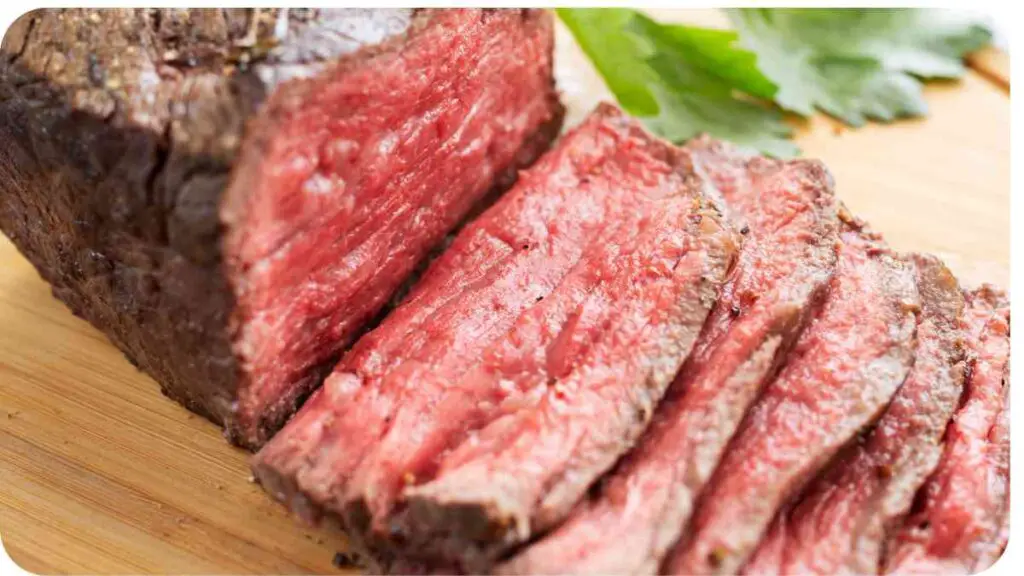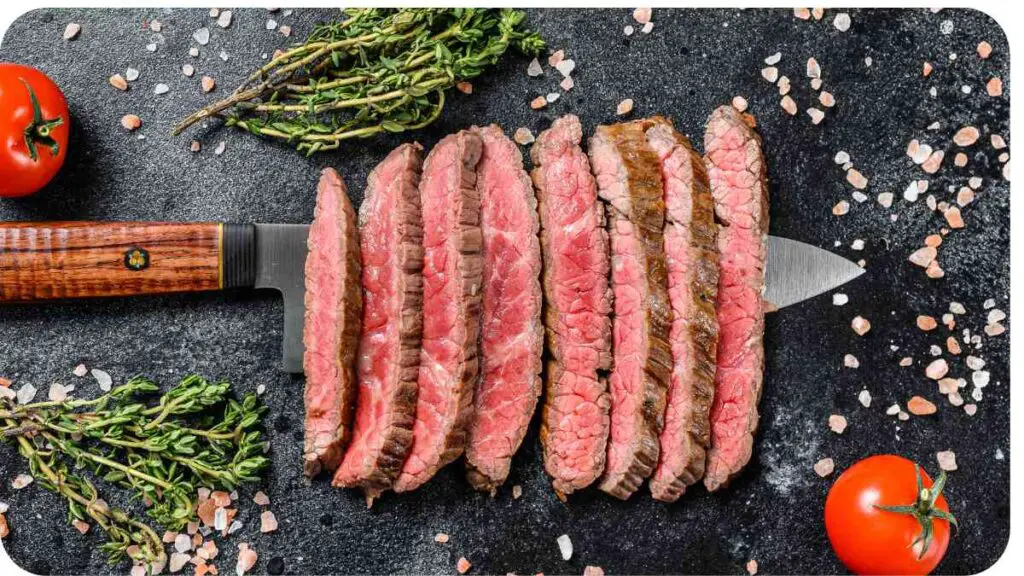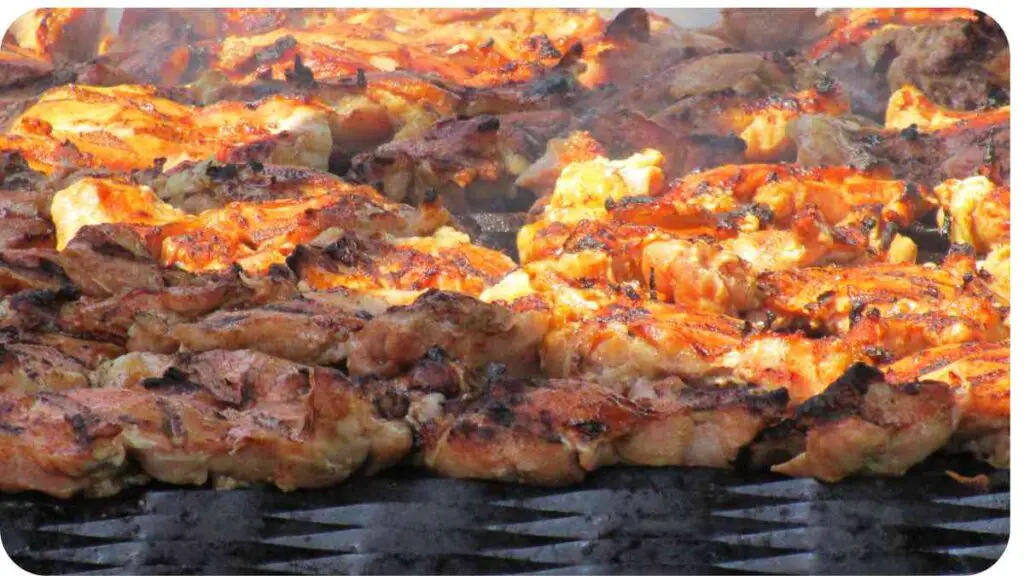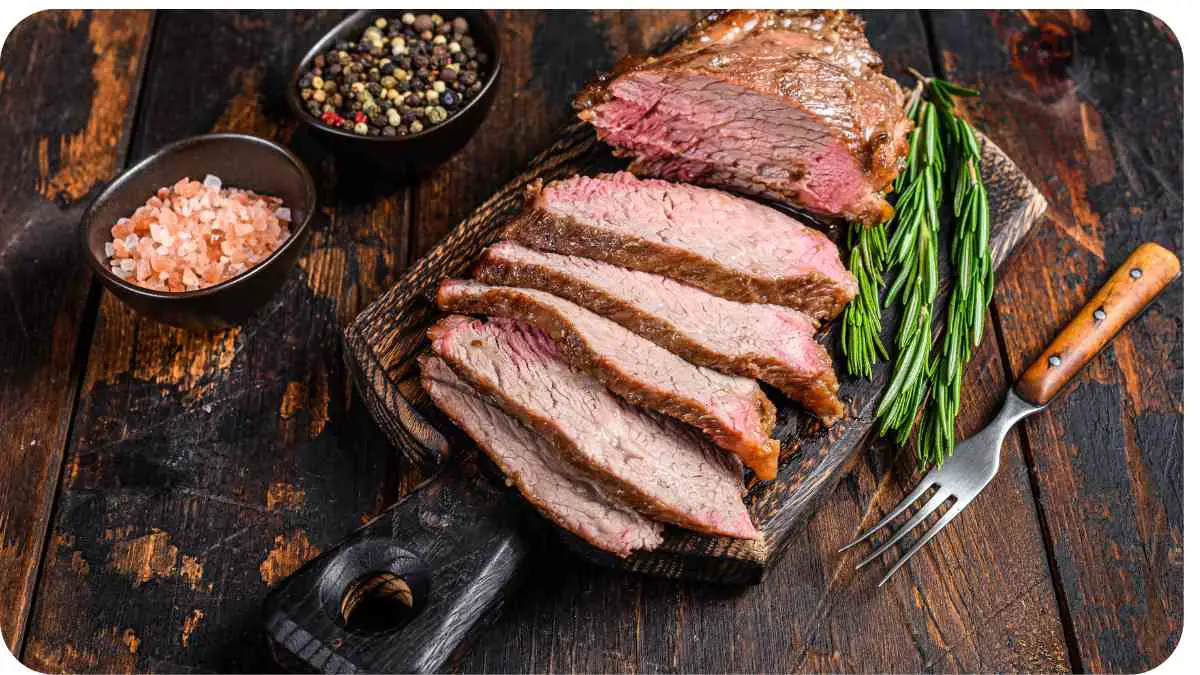As a steak enthusiast, you’ve likely encountered the ongoing debate over rare steak – is it undercooked or a culinary masterpiece? In this exploration, we’ll delve into the mystery behind the appeal of rare steak, health considerations, cooking techniques, and expert opinions. Get ready to unravel the secrets of rare steak cooking!
| Takeaway |
|---|
| Understanding Doneness: Rare steak offers a unique culinary experience with its tender texture and intense flavor. |
| Balancing Safety and Flavor: Achieving the perfect rare steak involves balancing flavor enhancements with safety protocols. |
| Global Perspectives: Explore how different cultures prefer their steaks cooked and savor the global nuances of doneness. |
| Science of Cooking: Delve into the science behind cooking meat, from protein denaturation to the Maillard reaction. |
| Alternative Techniques: Consider alternative cooking methods like sous vide and reverse searing for exceptional results. |
| Pairing Perfection: Elevate your dining experience by pairing rare steak with complementary sides for a well-rounded meal. |
2. The Appeal of Rare Steak

Rare steak has a devoted following due to its unique texture, tenderness, and intense flavor. The magic lies in preserving the natural juices and maintaining the meat’s succulence. Let’s explore why many steak lovers prefer their beef on the rarer side.
Dive into the art of steak perfection with 10 Secrets for the ultimate culinary experience.
Table 1: Characteristics of Rare Steak
| Attribute | Description |
|---|---|
| Texture | Tender and slightly chewy |
| Flavor Profile | Intense beef flavor |
| Juiciness | Abundant natural juices |
| Appearance | Pinkish-red center |
3. Health Considerations
Before we dive into cooking techniques, it’s crucial to address the health aspects of consuming rare steak. We’ll examine both the nutritional value it offers and potential safety concerns associated with undercooked meat.
3.1 Nutritional Value of Rare Steak
Rare steak is a rich source of essential nutrients like iron, zinc, and B vitamins. The minimal cooking preserves these nutrients, offering a more nutritionally dense option compared to well-done counterparts.
Embark on a culinary journey exploring The Science of Cooking Meat to elevate your understanding and cooking skills.
Table 2: Nutritional Content of Rare Steak (per 100g)
| Nutrient | Amount | % Daily Value (DV) |
|---|---|---|
| Iron | 2.9mg | 16% |
| Zinc | 5.4mg | 49% |
| Vitamin B12 | 2.1µg | 88% |
3.2 Safety Concerns
While rare steak can be nutritionally beneficial, safety is a paramount concern. Consuming undercooked meat poses risks of bacterial contamination. It’s essential to strike a balance between enjoying a rare steak and ensuring it’s safe for consumption.
Table 3: Safety Guidelines for Rare Steak
| Safety Aspect | Recommendation |
| Internal Temperature | Maintain a minimum of 145°F (63°C) |
| Resting Time | Allow steak to rest for at least 3 minutes |
| Quality Source | Choose high-quality, fresh meat |
4. Cooking Techniques for Rare Steak

Now that we understand the allure of rare steak and the health considerations, let’s explore the art of cooking it to perfection. The cooking technique plays a crucial role in achieving the desired doneness while ensuring both flavor and safety.
4.1 Searing vs. Slow Cooking
One of the key decisions when cooking a rare steak is choosing between searing and slow cooking methods. Each technique imparts a unique flavor and texture to the meat.
Elevate your roasting skills and achieve the perfectly cooked chicken with expert techniques and insider tips.
Table 4: Cooking Techniques Comparison
| Technique | Characteristics |
|---|---|
| Searing | High heat, quick cooking, caramelized crust |
| Slow Cooking | Low heat, longer duration, tender throughout |
4.2 Temperature Control
Maintaining precise temperature control is paramount when cooking rare steak. The internal temperature directly influences the doneness, and a few degrees can make a significant difference.
Table 5: Recommended Internal Temperatures
| Doneness Level | Internal Temperature Range |
|---|---|
| Rare | 125-130°F (52-54°C) |
| Medium Rare | 130-135°F (54-57°C) |
| Medium | 135-145°F (57-63°C) |
5. Factors Influencing Steak Doneness
Several factors contribute to the doneness of a steak, and understanding these elements allows you to have better control over the final result. Let’s explore the nuances of meat cut, thickness, marbling, fat content, and resting periods.
5.1 Meat Cut and Thickness
Different cuts and thicknesses require varying cooking times. For instance, a thick ribeye will need more time to reach the desired internal temperature compared to a thin sirloin.
Table 6: Cooking Times Based on Meat Cut and Thickness
| Cut | Thickness | Approximate Cooking Time (per side) |
|---|---|---|
| Ribeye | 1.5 inches | 5-7 minutes |
| Sirloin | 1 inch | 3-5 minutes |
| Tenderloin | 0.75 inch | 2-4 minutes |
5.2 Marbling and Fat Content
The marbling and fat content in a steak significantly influence its tenderness and flavor. Higher marbling contributes to a more succulent and flavorful rare steak.
Ignite your passion for BBQ with Grilling 101 and discover the secrets to achieving mastery in the world of outdoor cooking.
Table 7: Marbling and Fat Content Impact
| Marbling Level | Fat Content | Characteristics |
|---|---|---|
| High | 10-15% | Rich flavor, increased tenderness |
| Moderate | 6-10% | Balanced flavor and tenderness |
| Low | < 6% | Leaner, less flavorful, but still tender |
5.3 Resting Period
Allowing the steak to rest after cooking is crucial for redistributing juices and ensuring a juicy bite. The resting period also contributes to the final doneness.
Table 8: Recommended Resting Times
| Steak Thickness | Resting Time |
|---|---|
| 1 inch | 3 minutes |
| 1.5 inches | 5 minutes |
| 2 inches | 7 minutes |
6. Culinary Preferences Worldwide
Rare steak isn’t just a culinary preference; it’s a global phenomenon with different cultures offering unique perspectives on the ideal doneness. Let’s take a culinary journey and explore how various regions view and prepare their steaks.
6.1 Global Perspectives on Steak Doneness
Table 9: Steak Doneness Preferences Worldwide
| Region | Dominant Doneness | Notable Variations |
|---|---|---|
| United States | Medium Rare | Popular cuts: Ribeye, T-bone, New York Strip |
| France | Rare | Emphasis on flavor, often served with sauces |
| Argentina | Medium Rare | Grilled over open flames, chimichurri sauce |
| Japan | Rare to Medium Rare | High-quality Wagyu beef, thinly sliced |
| Australia | Medium Rare | Emphasis on natural flavors, often barbecued |
7. Debunking Common Myths
There are numerous myths surrounding rare steak, from the misconception of “blood” to safety concerns. Let’s debunk some common myths and shed light on the science behind the cooking process.
Delve into the world of sous vide with Is It Safe? What You Need to Know, unraveling the mysteries and benefits of this innovative cooking method.
7.1 Red Juice vs. Blood
One prevalent myth is that the red liquid in a rare steak is blood. In reality, it’s a mixture of water and a protein called myoglobin, responsible for the meat’s color.
Table 10: Red Juice vs. Blood
| Myth | Reality |
|---|---|
| Red juice is blood | Myoglobin and water create the red liquid |
| Bloodiness indicates freshness | Color is not a reliable freshness indicator |
7.2 Safety Myths
Concerns about safety often deter people from enjoying rare steak. By following proper guidelines and sourcing high-quality meat, the risks can be minimized.
Table 11: Addressing Safety Concerns
| Safety Myth | Reality |
|---|---|
| Rare steak is always risky | Safe consumption with proper handling and cooking |
| High-quality meat is immune to contamination | Quality matters, but proper handling is essential |
8. Expert Opinions
To gain a deeper understanding of rare steak, let’s turn to the experts in the culinary world. Renowned chefs share their insights on the nuances of cooking and enjoying this delicacy.
8.1 Renowned Chefs on Rare Steak
Table 12: Insights from Expert Chefs
| Chef | Perspective |
|---|---|
| Gordon Ramsay | Emphasizes the importance of seasoning and precise cooking |
| Julia Child | Advocates for high-quality ingredients and proper techniques |
| Francis Mallmann | Promotes the art of open-fire grilling for unique flavors |
| Heston Blumenthal | Explores scientific approaches for perfecting steak |
9. Perfecting the Art of Grilling

Grilling is a preferred method for many steak enthusiasts. Let’s explore some tips for grilling the perfect rare steak and common pitfalls to avoid.
9.1 Tips for Grilling Rare Steak
Grilling a rare steak requires attention to detail. Follow these tips to achieve optimal results:
Table 13: Grilling Tips for Rare Steak
| Tip | Description |
|---|---|
| Preheat the grill | Ensure a hot surface for searing and flavor development |
| Season generously | Enhance the natural flavors with salt, pepper, and herbs |
| Use a meat thermometer | Monitor the internal temperature for precision |
| Allow for proper resting | Ensure juices redistribute for maximum juiciness |
9.2 Common Pitfalls to Avoid
Avoiding common mistakes is essential for a successful grilling experience. Here are some pitfalls to steer clear of:
Table 14: Common Pitfalls in Grilling Rare Steak
| Pitfall | Prevention |
|---|---|
| Overcooking | Monitor temperature closely and avoid excessive flipping |
| Insufficient resting | Allow the steak to rest before slicing for optimal juiciness |
| Neglecting seasoning | Properly season to enhance the steak’s natural flavors |
| Inadequate preheating | Ensure the grill is sufficiently hot before placing the steak |
10. The Science Behind Cooking Meat
Understanding the science behind cooking meat is crucial for mastering the art of preparing rare steak. Let’s delve into the processes of protein denaturation and the Maillard reaction.
10.1 Protein Denaturation
When heat is applied to meat, proteins undergo denaturation, a process where they unfold and reorganize. This transformation contributes to the change in texture and color during cooking.
Table 15: Protein Denaturation in Meat Cooking
| Stage | Characteristics |
|---|---|
| Raw | Proteins in their natural state |
| Denaturation | Unfolding of proteins, change in texture |
| Coagulation | Proteins bond together, further texture change |
| Browning | Development of color and flavor |
10.2 Maillard Reaction
The Maillard reaction is a complex chemical process that occurs when amino acids and reducing sugars react at elevated temperatures. This reaction is responsible for the browning and development of rich flavors in the crust of a rare steak.
Table 16: Maillard Reaction in Steak Cooking
| Reaction Stage | Characteristics |
|---|---|
| Initial Stage | Aroma development, browning begins |
| Intermediate | Flavor intensifies, complex compounds form |
| Final Stage | Rich brown color, deepened flavor |
11. Achieving the Ideal Rare Steak
Now that we’ve explored the science behind cooking, let’s focus on achieving the perfect rare steak. This involves understanding recommended internal temperatures and the importance of resting time.
11.1 Recommended Internal Temperatures
To achieve the desired doneness, it’s crucial to monitor the internal temperature of the steak.
Table 17: Internal Temperatures for Different Doneness Levels
| Doneness Level | Internal Temperature Range |
|---|---|
| Rare | 125-130°F (52-54°C) |
| Medium Rare | 130-135°F (54-57°C) |
| Medium | 135-145°F (57-63°C) |
11.2 Resting Time Guidelines
Allowing the steak to rest after cooking is equally important. This ensures that juices redistribute, resulting in a juicy and flavorful experience.
Table 18: Recommended Resting Times
| Steak Thickness | Resting Time |
|---|---|
| 1 inch | 3 minutes |
| 1.5 inches | 5 minutes |
| 2 inches | 7 minutes |
12. Balancing Flavor and Safety
While pursuing the perfect rare steak, it’s crucial to strike a balance between enhancing flavor and ensuring safety. Let’s explore methods for elevating the taste without compromising on safety.
12.1 Flavor Enhancements
Enhancing the flavor of a rare steak can be achieved through various methods. Consider the following:
Table 19: Flavor Enhancements for Rare Steak
| Enhancement | Description |
|---|---|
| Herb Butter | Infuse butter with herbs for added richness |
| Balsamic Glaze | Drizzle a reduction for a sweet and tangy flavor |
| Garlic Rub | Apply a garlic rub before grilling for depth |
| Compound Marinades | Experiment with marinades for unique flavor profiles |
12.2 Safety Protocols
Maintaining safety while enjoying a rare steak is paramount. Follow these protocols to minimize risks:
Table 20: Safety Protocols for Consuming Rare Steak
| Safety Measure | Description |
|---|---|
| Source High-Quality Meat | Choose fresh, reputable sources for the best quality |
| Use a Meat Thermometer | Ensure the internal temperature meets safety standards |
| Practice Proper Hygiene | Avoid cross-contamination and practice safe handling |
13. Alternative Cooking Methods
While grilling is a popular method, there are alternative cooking techniques that can yield exceptional results for rare steak. Let’s explore the sous vide method and reverse searing.
13.1 Sous Vide
Sous vide involves cooking meat in a vacuum-sealed bag at a precise low temperature. This method ensures even doneness throughout the steak.
Table 21: Sous Vide Cooking Process
| Stage | Description |
|---|---|
| Vacuum Sealing | Seal the steak with desired seasonings in a bag |
| Precision Cooking | Submerge the bag in a water bath at a set temperature |
| Searing Finish | Sear briefly for a caramelized crust |
13.2 Reverse Searing
Reverse searing involves slow-cooking the steak at a low temperature before finishing with a high-heat sear. This method produces a tender interior and a flavorful crust.
Table 22: Reverse Searing Process
| Stage | Description |
|---|---|
| Low-Temperature Cook | Slow-cook the steak at a low temperature |
| High-Heat Sear | Finish with a quick sear for a caramelized crust |
14. Pairing Rare Steak with Sides
To elevate the dining experience, pairing your rare steak with complementary sides is essential. Let’s explore the art of balancing flavors and textures to create a well-rounded meal.
14.1 Complementary Flavors
Pairing your rare steak with sides that complement its richness is key to a satisfying meal. Consider the following flavor combinations:
Table 23: Complementary Flavor Pairings
| Steak Type | Complementary Flavors |
|---|---|
| Ribeye | Creamy mashed potatoes, sautéed mushrooms |
| Filet Mignon | Roasted vegetables, truffle mac and cheese |
| New York Strip | Crispy fries, blue cheese salad |
| T-bone | Garlic butter asparagus, loaded baked potatoes |
14.2 Recommended Side Dishes
To create a well-rounded meal, choose sides that offer a variety of textures and flavors to complement the rare steak.
Table 24: Recommended Side Dishes for Rare Steak
| Side Dish | Description |
|---|---|
| Garlic Parmesan Fries | Crispy fries seasoned with garlic and Parmesan |
| Grilled Asparagus | Asparagus spears grilled with olive oil and garlic |
| Truffle Mac and Cheese | Creamy mac and cheese infused with truffle oil |
| Mixed Berry Salad | Fresh berries tossed with balsamic vinaigrette |
15. Conclusion
In conclusion, unraveling the mystery of rare steak involves understanding its appeal, considering health factors, mastering cooking techniques, and appreciating global culinary preferences. Armed with insights from expert chefs, knowledge of the science behind cooking, and alternative methods, you can confidently pursue the perfect rare steak experience.
Whether you prefer the traditional grilling approach or want to explore sous vide and reverse searing, the key lies in achieving the ideal internal temperature and allowing for proper resting. Balance flavor enhancements with safety protocols and experiment with complementary side dishes to create a memorable dining experience.
Rare steak isn’t just a meal; it’s a culinary adventure. Embrace the art, science, and diverse perspectives surrounding this delectable dish, and savor every juicy, flavorful bite. Happy cooking!
Further Reading
- Myoglobin: The Culprit Behind the Misconception of Bloody Undercooked Meat: This article explores the science behind the red liquid in rare steak, debunking the myth that it is blood. Learn about myoglobin and its role in creating the unique color of undercooked meat.
- UTI Infection: Prevention and Treatment: Delve into this NPR article for valuable information on preventing and treating urinary tract infections (UTIs). Understanding these aspects of healthcare is essential for overall well-being.
- The Reason Rare Steak Is Usually Safe to Eat: Tasting Table provides insights into the safety of consuming rare steak. Uncover the reasons behind why well-prepared rare steak is generally safe and enjoy the culinary experience with confidence.
FAQs
Is rare steak safe to eat?
Yes, when prepared correctly, rare steak is safe to eat. Ensure you follow proper cooking guidelines, including reaching the recommended internal temperature and allowing for adequate resting time.
What is the red liquid in rare steak?
The red liquid in rare steak is not blood but a mixture of water and myoglobin, a protein responsible for the meat’s color. It’s crucial to understand this to dispel the misconception.
Can I prevent UTI infections?
Preventing urinary tract infections (UTIs) involves maintaining good hygiene, staying hydrated, and avoiding irritants. Regularly emptying your bladder and practicing safe sex can also contribute to prevention.
How does myoglobin affect the color of meat?
Myoglobin undergoes changes during cooking, leading to protein denaturation and the Maillard reaction. These processes contribute to the color changes in meat, dispelling the notion of it being “bloody.”
What are alternative cooking methods for rare steak?
Sous vide and reverse searing are alternative methods for cooking rare steak. Sous vide involves precise low-temperature cooking, while reverse searing combines slow cooking with a high-heat sear for optimal results.

Hi, I’m Hellen James! I’m a professional chef who has been cooking for over 12 years. In my career, I’ve worked at some of the world’s most prestigious hotels and restaurants. My expertise lies in creating recipes that are simple but delicious, and I love to experiment with new ingredients and techniques. I started this blog because I want to share my passion for cooking with everyone who loves food as much as I do.


